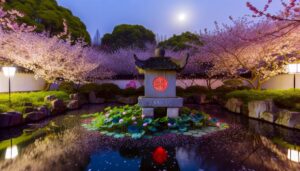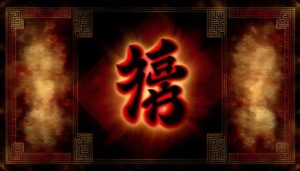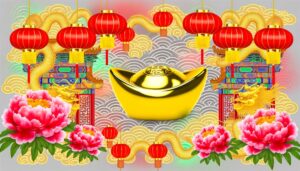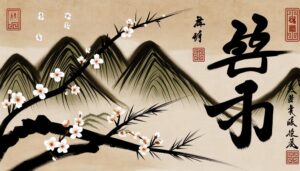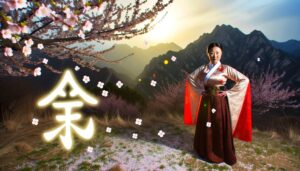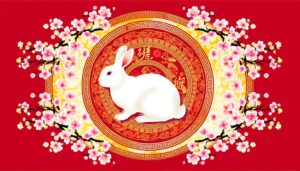Chinese Symbol Long Life: What Is It?
The Chinese symbol for long life, known as 'Shou' (寿), is deeply entrenched in Chinese culture with origins dating back to the Han Dynasty. This symbol is influenced by Confucianism and Daoism, emphasizing life's continuity and the pursuit of longevity.
'Shou' is omnipresent in Chinese art, calligraphy, and architecture, representing blessings and prosperity. It is widely used in decorative items, ceremonial garments, and celebrations, reflecting its profound cultural significance.
The symbol also features prominently in folklore, associated with deities and mythical creatures. To uncover more about its multi-layered role across various aspects of Chinese society, continue exploring.
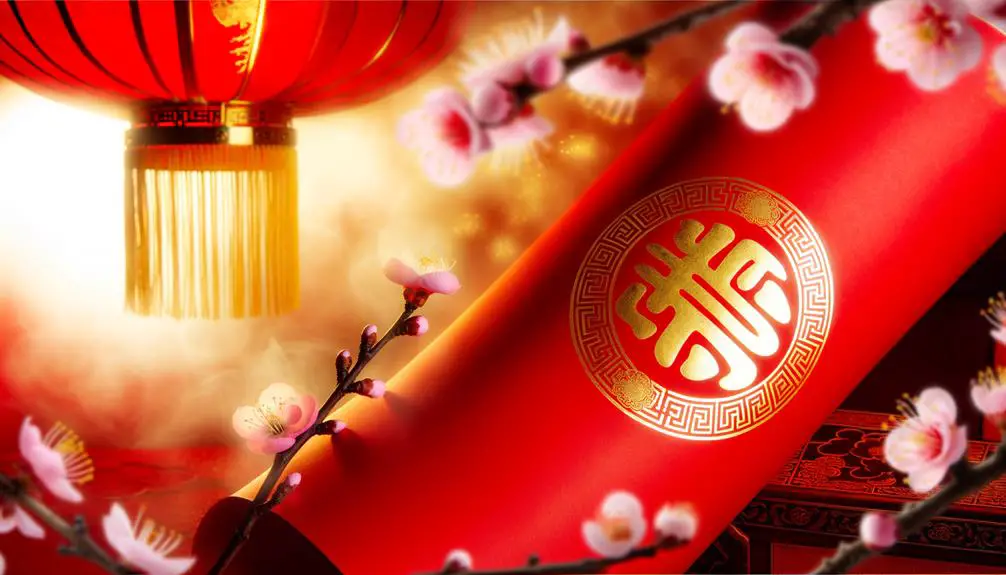
Key Takeaways
- The Chinese symbol for long life originated during the Han Dynasty and is deeply rooted in Confucian, Daoist, and Buddhist traditions.
- It is commonly seen in Chinese calligraphy, painting, and home decor, symbolizing blessings, prosperity, and well-being.
- The symbol appears frequently in architectural designs, especially temples, and is a popular motif in festivals and celebrations.
- It holds significant cultural value, symbolizing longevity and continuity, and is often used in ceremonial garments, jewelry, and amulets.
- The symbol is linked to mythological figures like Shouxing and is featured prominently in New Year festivities and other cultural celebrations.
Historical Origins
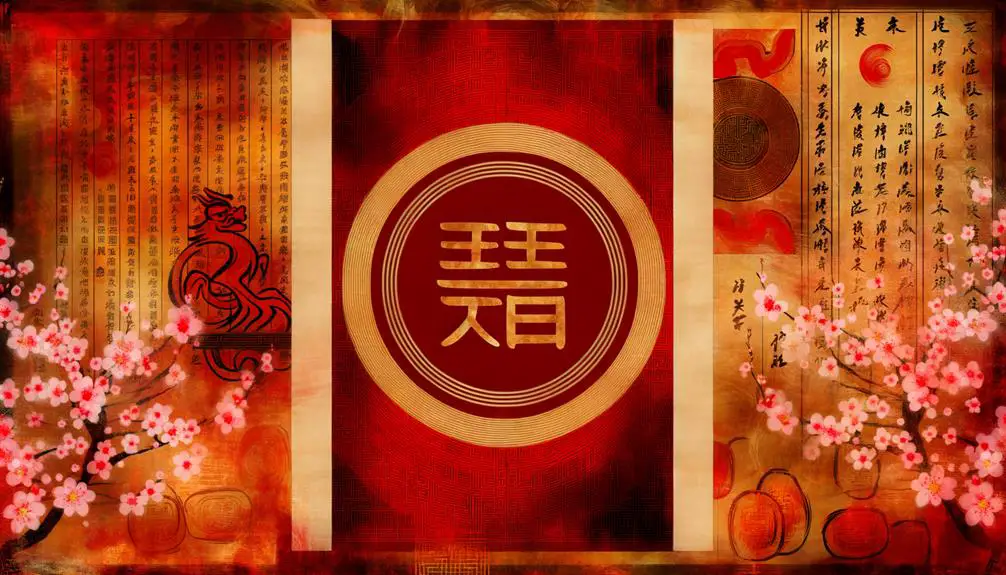
The historical origins of the Chinese symbol for long life, often represented by the character '寿' (shòu), can be traced back to ancient Chinese culture where it held significant philosophical and spiritual meaning.
The character emerged during the Han Dynasty (206 BC–220 AD), a period when Confucianism and Daoism were profoundly influential. In Confucian thought, long life was closely associated with virtues like filial piety and moral integrity. Concurrently, Daoist traditions revered longevity as an embodiment of harmony with nature and the cosmos.
The symbol '寿' evolved through pictographic and ideographic representations, reflecting the synthesis of these philosophical schools. Its enduring legacy highlights a cultural emphasis on life's continuity and the aspiration for an existence in accordance with natural and ethical principles.
Cultural Significance
Building upon its historical roots, the Chinese symbol for long life continues to permeate contemporary culture, manifesting in various aspects of daily life, art, and traditional practices.
This emblem is often featured in home decor, such as embroidered textiles and ceramic ware, symbolizing a wish for longevity and prosperity.
Festivals and celebrations frequently incorporate this symbol, reinforcing communal values and intergenerational bonds.
In Chinese calligraphy and painting, the character for long life serves as a common motif, blending aesthetic beauty with cultural reverence.
Additionally, it appears in architectural design, particularly in temples and ancestral halls, reflecting its enduring significance.
The symbol's prevalence across these domains underscores its integral role in maintaining cultural identity and continuity.
Symbolism and Meaning
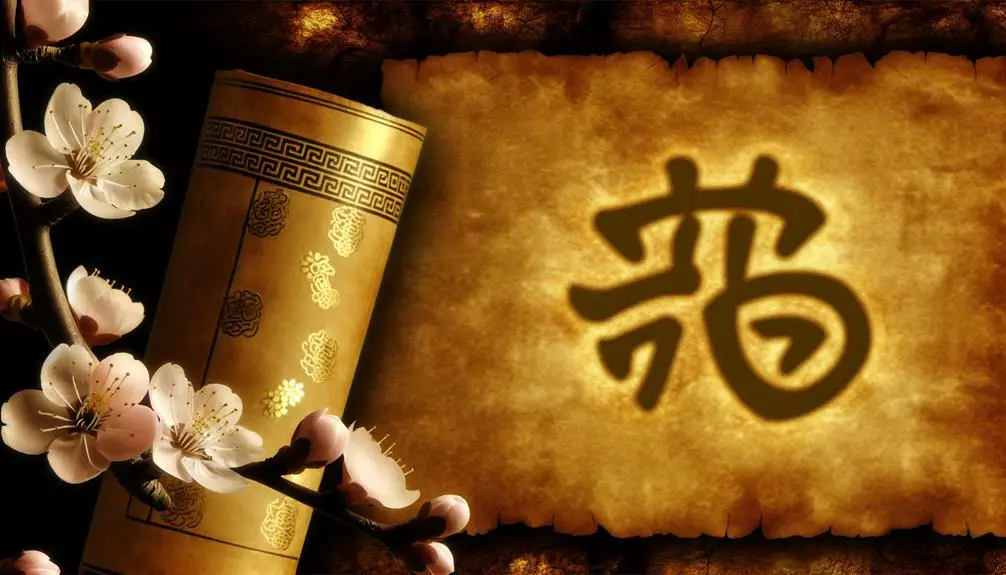
The Chinese symbol for long life, known as 'Shou' (寿), embodies profound traditional cultural significance, often appearing in various artistic representation styles such as calligraphy, embroidery, and porcelain.
These depictions are not only aesthetically diverse but also imbued with layers of meaning that have evolved over centuries.
In contemporary contexts, this symbol retains its revered status, finding modern interpretations and uses in designs that bridge the ancient with the present.
Traditional Cultural Significance
Rooted deeply in Chinese culture, the symbol for long life, often represented by the character '寿' (shòu), encapsulates a rich tapestry of historical significance and philosophical ideals. Revered for millennia, this symbol is more than just a character; it embodies essential elements of Chinese thought and tradition.
- Confucianism: It reflects Confucian values of filial piety and respect for elders.
- Daoism: It aligns with Daoist principles, emphasizing harmony with nature and the pursuit of longevity.
- Buddhism: It resonates with Buddhist teachings, symbolizing the quest for enlightenment and a life free from suffering.
- Cultural Practices: Seen in various cultural artifacts, such as calligraphy, ceramics, and textiles, it signifies blessings, prosperity, and well-being.
This multifaceted symbol continues to be a cornerstone of Chinese cultural identity.
Artistic Representation Styles
In various artistic representation styles, the Chinese symbol for long life is intricately woven into the fabric of visual arts, each style imbuing the character with layers of cultural and philosophical meaning.
Traditional brush painting often features the symbol in conjunction with natural elements like pine trees and cranes, signifying resilience and longevity.
Calligraphy treats the character as both a linguistic and aesthetic entity, with each stroke reflecting an artist's intention and spiritual contemplation.
In textile arts, the symbol is frequently integrated into intricate embroidery patterns, symbolizing enduring prosperity.
These varied artistic expressions not only highlight the symbol's aesthetic appeal but also embody its embedded philosophical values, enriching its significance across different mediums.
Modern Interpretations and Uses
Interpreting the Chinese symbol for long life in contemporary contexts reveals its evolving significance, as it is increasingly utilized in modern design, wellness practices, and digital media to convey timeless values of health, prosperity, and spiritual fulfillment.
The symbol's adaptability can be seen in:
- Interior Design: Enhancing spaces with motifs that promote longevity and positive energy.
- Fashion: Incorporating the symbol in clothing and accessories to evoke cultural heritage and modern aesthetics.
- Digital Media: Utilizing the emblem in apps and websites to signify wellness and holistic living.
- Wellness Practices: Integrating the symbol in yoga, meditation, and alternative therapies for its spiritual connotations.
This multi-faceted use underscores the symbol's enduring relevance in an ever-evolving world.
Artistic Depictions
The artistic depictions of the Chinese symbol for long life are rich in both historical tradition and contemporary innovation. Traditional calligraphy emphasizes the fluidity and precision of brush strokes, each line and curve meticulously crafted to convey the cultural significance of longevity.
In contrast, modern design interpretations adapt these elements to diverse mediums, incorporating the timeless symbol into minimalist aesthetics, digital art, and commercial design, thereby bridging ancient heritage with contemporary creativity.
Calligraphy and Brush Strokes
Mastering the calligraphy of the Chinese symbol for long life necessitates a deep understanding of brush strokes, each meticulously crafted to convey both aesthetic beauty and cultural significance.
The elegance of this symbol lies in the precision of its execution, which can be dissected into four critical components:
- Stroke Order: The sequence in which strokes are applied ensures structural integrity and flow.
- Brush Pressure: Varying pressure creates dynamic lines, adding depth and dimension.
- Ink Consistency: Proper ink dilution impacts the texture and tonal quality of the strokes.
- Stroke Speed: The rhythm of each stroke, whether swift or deliberate, imparts emotion and grace.
These elements harmoniously blend to create a symbol that resonates with longevity, embodying centuries of artistic tradition and cultural ethos.
Modern Design Interpretations
In contemporary art and design, the Chinese symbol for long life is reimagined through various mediums, blending traditional aesthetics with modern innovation to produce works that are both culturally resonant and visually compelling. Modern interpretations can be found in diverse formats such as digital art, fashion, and interior design. These adaptations not only preserve the symbol's cultural significance but also enhance its visual appeal in a global context.
| Medium | Characteristics |
|---|---|
| Digital Art | Utilizes vibrant colors and dynamic animations |
| Fashion | Integrates embroidery and print techniques |
| Interior Design | Features minimalist and elegant motifs |
Through these mediums, the symbol for long life continues to evolve, maintaining its relevance and appeal in contemporary society.
Traditional Uses
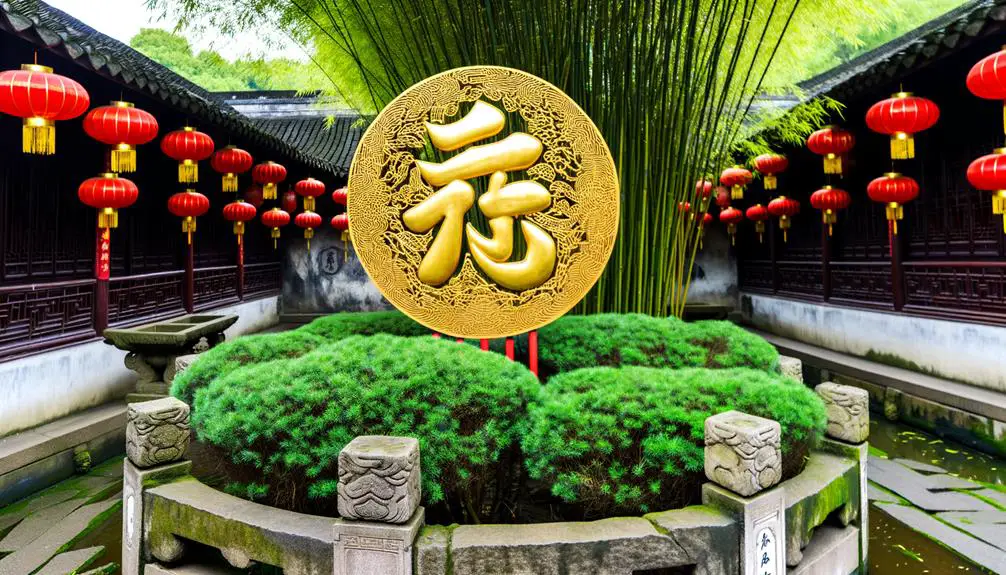
Throughout centuries, the Chinese symbol for long life has been intricately woven into various facets of cultural practices and artistic expressions, symbolizing not only longevity but also prosperity and well-being. Its traditional uses span a wide array of applications, reflecting its deep cultural significance:
- Ceremonial Garments: Embroidered on clothing worn during significant life events, such as weddings and birthdays, to bestow blessings of longevity.
- Architecture: Incorporated into the designs of temples and homes to invoke protection and enduring prosperity.
- Jewelry and Amulets: Crafted into wearable items to provide continuous personal protection and fortune.
- Art and Calligraphy: Featured prominently in paintings and scrolls, serving as a visual affirmation of the values of life and continuity.
These applications underscore the symbol's enduring presence in Chinese heritage.
Symbol in Folklore
The Chinese symbol for long life holds profound ancient cultural significance, often intertwined with mythological origins that have been passed down through generations.
This symbol frequently appears in folklore, where it is believed to bestow longevity and good fortune upon those who embrace it.
Its presence is particularly notable in various celebrations, such as birthdays and New Year festivities, underscoring its enduring relevance and revered status in Chinese traditions.
Ancient Cultural Significance
Rooted deeply in Chinese folklore, the symbol for long life, often depicted as the character '寿' (shòu), embodies a rich tapestry of mythological narratives and cultural reverence. This emblematic character is omnipresent in various facets of traditional Chinese culture, symbolizing more than just longevity. Its ancient cultural significance is reflected in:
- Festivals: Widely used during celebrations such as the Chinese New Year and birthdays.
- Art: Found in intricate designs on pottery, textiles, and paintings.
- Architecture: Frequently carved into the woodwork and stone of ancient buildings.
- Gift-giving: Commonly presented in the form of calligraphy scrolls or embroidered items to convey best wishes.
These aspects underscore the profound respect and importance attributed to the concept of long life in Chinese society.
Mythological Origins
Mythological narratives surrounding the Chinese symbol for long life, or 'shòu' (寿), reveal its origins in stories of ancient deities, legendary figures, and auspicious creatures that embody the virtues of longevity and eternal energy. The symbol is intricately linked with the Jade Emperor, who is believed to bestow long life upon the righteous. Additionally, the mythological figure Shouxing, often depicted with a prominent forehead and holding a peach, is revered as the God of Longevity. Auspicious creatures like the crane and tortoise are also emblematic of endurance and resilience.
| Mythological Figure/Creature | Symbolic Attribute |
|---|---|
| Jade Emperor | Bestower of Longevity |
| Shouxing | God of Longevity |
| Crane | Symbol of Endurance |
| Tortoise | Emblem of Resilience |
Symbol in Celebrations
Drawing from its mythological origins, the Chinese symbol for long life, 'shòu' (寿), holds a prominent place in traditional celebrations, often manifesting in various forms to convey wishes of longevity and prosperity. The symbol is intricately woven into social and cultural fabrics, appearing in diverse settings:
- Birthday Banquets: Seen on decorations and dishes, emphasizing the wish for long life.
- Weddings: Embellished on gifts and attire, symbolizing enduring union and health.
- New Year Festivities: Integrated into decorations to usher in a year of longevity and prosperity.
- Cultural Artifacts: Featured on items like clothing, paintings, and jewelry, reinforcing its significance.
These applications highlight 'shòu's' enduring cultural relevance, reflecting a deep-rooted veneration for longevity within Chinese society.
Modern Applications

In contemporary society, the Chinese symbol for long life has found its way into various domains, from home décor and fashion to wellness practices and digital media, reflecting its enduring cultural significance and adaptability.
Its incorporation into home décor ranges from intricate wall hangings to elegant ceramics, signifying prosperity and well-being.
In fashion, it appears on clothing and accessories, merging traditional aesthetics with modern design.
Wellness practices harness the symbol's positive connotations, often seen in meditation spaces and health products to promote holistic well-being.
Additionally, digital media has embraced the symbol through apps and online platforms, where it serves as an emblem of longevity and good fortune, thereby bridging ancient traditions with contemporary lifestyles.
Decorative Elements
Building upon its modern applications, the Chinese symbol for long life has become a prominent feature in decorative elements, where its intricate designs and profound meanings enhance the aesthetic and cultural value of various items.
This symbol is often incorporated into:
- Textiles: Embroidered on silk garments and tapestries, adding elegance and cultural significance.
- Ceramics: Adorned on porcelain vases and plates, symbolizing durability and timeless beauty.
- Furniture: Carved into wood, it elevates everyday objects into heirlooms.
- Architectural Features: Engraved on doors and windows, symbolizing protection and prosperity.
Each application not only beautifies the item but also infuses it with layers of tradition and meaning, making the symbol a versatile and cherished motif in both historical and contemporary contexts.
Symbol in Jewelry
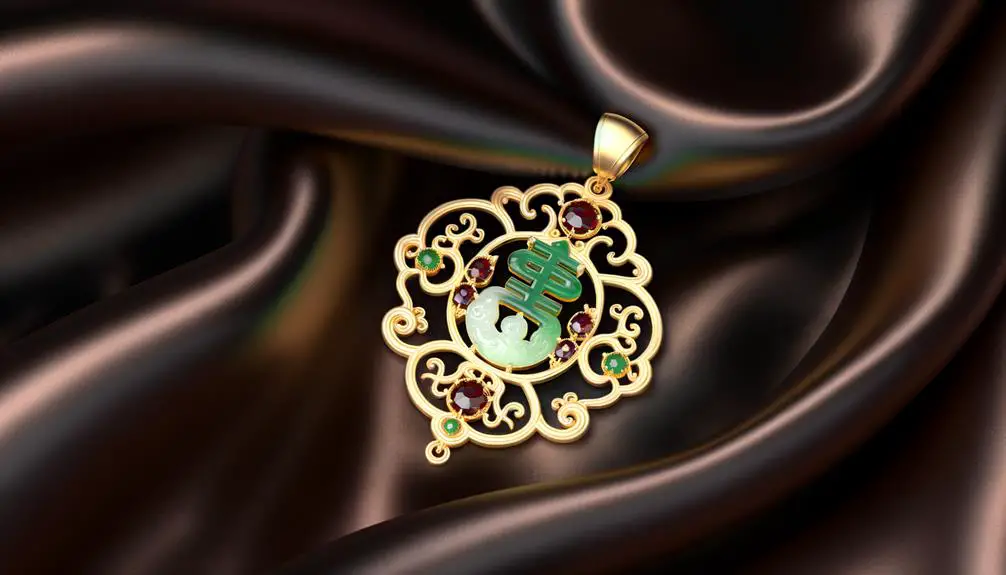
The Chinese symbol for long life, when integrated into jewelry designs, serves not only as an aesthetic embellishment but also as a bearer of cultural heritage and personal significance.
These pieces often feature intricate craftsmanship, rendering the symbol in various materials such as gold, silver, jade, and enamel.
The enduring allure of this symbol lies in its dual function: it is both an ornamental accessory and a talisman imbued with wishes for longevity and prosperity.
The meticulous incorporation of this emblem into rings, necklaces, and bracelets reflects a deep respect for tradition and a desire to convey meaningful wishes.
This fusion of beauty and symbolism guarantees that such jewelry resonates profoundly with both the wearer and the observer.
Global Influence
Across diverse cultures and societies, the Chinese symbol for long life has transcended its traditional roots to become a universal emblem of enduring strength and well-being.
This symbol's global influence is evident through various cultural integrations and adaptations:
- Fashion: Incorporation into global fashion, from clothing designs to accessories, symbolizing elegance and permanence.
- Home Décor: Use in interior design elements, such as wall art and ceramics, promoting a sense of peace and prosperity.
- Tattoo Artistry: Popular choice in body art, representing personal aspirations for health and wellness.
- Corporate Branding: Adoption by international brands to convey messages of durability and trustworthiness.
These adaptations highlight the symbol's ability to resonate universally, bridging cultural divides while retaining its profound significance.
Conclusion
To wrap up, the Chinese symbol for long life, deeply rooted in historical origins and rich cultural significance, goes beyond mere representation to embody profound philosophical ideals.
Through its diverse artistic portrayals and traditional uses, it remains a timeless emblem of essentiality and resilience.
Whether integrated into the fabric of modern applications or embellishing global jewelry, this symbol's enduring presence eloquently communicates humanity's universal desire for longevity and well-being, serving as a link between ancient wisdom and contemporary life.

